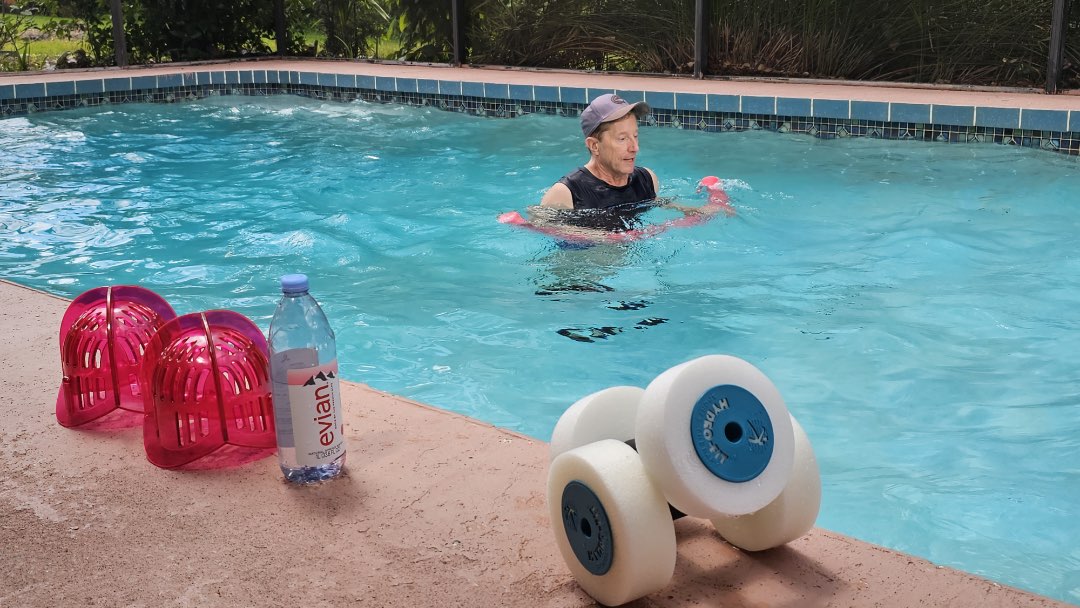Take away a 10-move circuit that can be performed with or without equipment. Upper Body Cardio Circuit can easily be added into any of your regular aqua fitness classes. The video features the same 10-move cardio circuit performed four times. The first 5-minute circuit is performed without equipment and the other three circuits are performed with a pool noodle, hand buoys and Aqualogix drag belles.
The purpose of this 20-minute water fitness instructor video is to show how instructing the same 10-move cardio circuit four times with different equipment will change the muscle actions each time. It is okay to teach the circuit with the same equipment each time. This video also emphasizes the importance of repeating sets or circuits of exercises for optimal muscular strength and endurance gains. Below, Mark talks more about creating an upper body cardio circuit that can be instructed with a variety of equipment. Then read on for a summary of the four circuits.
Upper Body Cardio Circuit Video-at-a-Glance
This 20-minute aqua video does not include a warm-up or cool down because this short upper body routine is meant to be instructed as a portion of a class. Below, read about how the same 10-move cardio circuit is performed four times.
Circuit 1: No Equipment
The first 5-minute circuit is performed without equipment and could technically serve as the warm-up in your classes. As a fitness professional for over 30 years, I have learned it is ideal if you can show exercises first without equipment and then show the same exercises using equipment. While this is not always feasible, it does encourage your class members to skip the equipment if it bothers them. Ultimately, class participants need to own their own exercise experience and avoid anything that causes pain or discomfort.
Circuit 2: Pool Noodle
The same 5-minute circuit is performed with a pool noodle for upper body resistance. The noodle is foam and is acted on by the upward forces of buoyancy, which means movement is resisted downwards. Buoyancy is the opposite of gravity. In gravity, the resistance is upwards. The length of the noodle can make some of the cardio moves awkward. In the video, I switched the noodle to one side in a couple of the exercises. The pool noodle I used in the video is a solid core noodle. The solid core noodles provide more resistance without the hole in the center. However, typical Dollar Store noodles with the hole in the center can absolutely be used here. The solid core noodles by Oodles of Noodles be purchased in a three-pack on Amazon.
Circuit 3: Hand Buoys
In this circuit, a pair of foam hand bars are used. The hand buoys are also acted on by the upward forces of gravity. Class members may find that this circuit feels more comfortable in terms of coordination because they are exercising with a pair of buoys, as opposed to one long pool noodle. Consider using a small or medium pair of foam dumbbells. The large sized buoys are nearly impossible for most people to exercise properly with. The larger buoys elevate participant’s shoulders, which can lead to shoulder impingement issues. Thera-Band has a pair of small-sized buoys available on Amazon, as well as a pair of medium sized buoys.
Circuit 4: Hydrorevolution Upper Body Drag Resistance
The last time through, I am demonstrating with the Aqualogix Upper Body Drag bells. Drag resistance is the same with or without equipment. And so the muscle actions in this circuit are the same as using no equipment. However, the drag bells have a larger suface area and thus create greater upper body resistance. In drag resistance, both sides of a muscle pair are targeted. When using foam equipment, only one side of the muscle pair is targeted. To instruct more resistance for the anterior muscle groups of the upper body, the chest, anterior deltoids and biceps, make sure the students have the flat side UP. Cue the flat side DOWN if you want to target the posterior muscle groups, the lats, posterior deltoids and triceps.

Repetition of Sets
Instructors often feel like they must have a class jam-packed with different exercises. They may feel like the class members will get bored if exercises are repeated. Well, if students want to be entertained, that might be a valid point. But if students want results, the science behind muscular endurance and strength training supports the repetition of sets of exercises for optimal muscular hypertrophy. In the gym, exercises are repeated for several sets. Repeating exercises for the same muscle groups causes breakdown of muscle fibers. This is how muscle mass is sustained and developed. In this video, the circuits represent sets. Therefore, repeating the circuit is encouraged.
Thanks for watching the video and reading this blog. Sometimes I wonder if these blogs are read by anyone. So if you get a chance, drop me a message or comment below this blog and let me know you read the blogs.